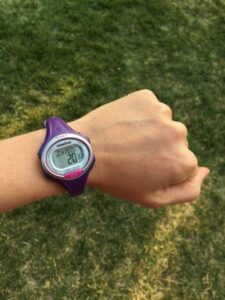
Maximizing results in the gym may seem all about how many grueling hours we exercise. However, new research indicates that we can train smarter instead of longer by changing up protocols and moves. In fact, short intense bouts such as micro-HIIT in or out of the gym, may prove even more beneficial for overall health and fitness than prolonged steady-state exercise.
Short in Duration, Long on Results
“Micro workouts can be super effective for people who don’t have time to make it to the gym,” says trainer Michael Massetti . “They are a great way to keep your full body engaged while keeping your heart rate elevated.” The idea behind micro workouts is based on HIIT, or High Intensity Interval Training.
HIIT interval training encompasses short bursts of high- intensity activity followed by periods of active rest. According to the American College of Sports Medicine, high-intensity intervals describe exercises performed at 80%-95% of one’s maximum heart rate, lasting anywhere between 5 seconds and 8 minutes. Higher levels of intensity accompany the shorter intervals. The work load alternates with equal time periods of active recovery, performed at 40%-50% of maximum heart rate. Often this time frame varies depending on the fitness level of the participant.
No Equipment? No Problem
HIIT is highly adaptable for varying fitness levels and goals, which explains its popularity among elite athletes as well as individuals undergoing cardiac rehabilitation. Any typical gym equipment can suffice, from stationary cycles to treadmills or rowing machines. In the absence of accessibility to a fitness center, bodyweight exercises such as pull-ups, push-ups or burpees can serve the same purpose.
Research shows that even a quick 11-minute workout that contains a full minute of high-intensity, all-out effort might deliver the same benefit as engaging in a 50-minute, moderately-paced workout, according to a study in the journal PLOS One. This 4-minute workout involves 40 seconds of all-out movement followed by 20- second rest intervals:
- 40 seconds of squats
- 20 seconds of rest
- 40 seconds of pull-up’s
- 20 seconds of rest
- 40 seconds of “mountain climbers”
- 20 seconds of rest

- Jump Rope, 60 seconds
- Forearm Plank, 60 seconds
- Walking Lunges, 60 seconds
- Jumping Jacks, 60 seconds
- Rest or Active recovery, 60 seconds
Try to complete four rounds for a thorough and exhaustive training session!
Small Bursts Add Up
The physical activity guidelines put forth by the CDC (Centers for Disease Control) recommend striving for 150 minutes of moderate-intensity work per week, in order to maintain a healthy body. However, within those parameters, no specific details exist regarding how to achieve or accumulate these minutes. Experts have concluded that engaging in brief but intense workouts more frequently (10 minutes of effort, 3 times a day) can offer a desirable and convenient option for individuals who already face a time crunch.
“We’re all super busy, so it can be hard to find motivation during precious downtime,” says Ivana Bolf, a trainer at Body Space Fitness in New York. “It’s important to get moving whenever possible, even if it’s for short periods of time.” Bolf clarifies that engaging in a 10-minute session of yoga flows does not yield these same benefits. Instead, she recommends micro-workouts that boost intensity.
“I find EMOMs (every minute on the minute) to be the most efficient and challenging workout,” she says. “Basically, I’d set a timer for 10 minutes. At the top of the minute, I begin a set of 3 to 4 exercises to complete as fast as possible within that minute. Whatever time I have left after finishing the exercises qualifies as recovery time.”
Aerobic and Anaerobic Systems
Tom Cowan, an exercise physiologist with the Centre for Human Health and Performance (CHHP) in London, echoes this sentiment. “The best way to explain it is repeated bouts of high intensity followed by a bout of recovery,” he says. Ramping up a workout’s intensity forces the body to tap into its anaerobic system for energy, since it cannot possibly supply the oxygen required to work aerobically as quickly as needed.
The recovery intervals enable the body to revert back to an aerobic system. As such a workout session continues, the body begins to rely less on the anaerobic system, as quick-release energy sources of phosphocreatine and glycogen get depleted. This reverts the body’s reliance back to the aerobic system, which releases energy slowly but more sustainably from stored fat. Intensity naturally begins to taper off, yet Cowan views this as an overall double win: “You’re essentially using a mixture of the anaerobic and aerobic systems, so you get an improvement in both.”
He points out that utilizing anaerobic respiration taxes many of the body’s systems, stressing the importance of clearing resulting lactic acid and hydrogen ions from the bloodstream. “All of those things increase the workload following the exercise….three sessions a week is probably okay, but it’s not something that you’re recommended to do every day.”
New Health Benefits on the Micro-HIIT Horizon
We already know that HIIT reduces fat – both surface adipose tissue as well as deeper, visceral fat that tends to surround inner organs – while enabling the body to hold onto hard-earned muscle mass. Now, athletes and novices alike have welcomed the micro-HIIT news, which points to improvements in overall fitness, cardiovascular health, cholesterol profiles and insulin sensitivity.
According to a 2017 study published in the journal Cell Metabolism, bouts of HIIT and micro-HIIT can possibly slow cellular aging by increasing the production of proteins within the mitochondria, the cells’ energy-releasing powerhouses. Other forms of exercise, such as strength training, also induce this benefit, albeit at a lesser level. In the absence of any significant physical exercise, cells (and the mitochondria in particular) will deteriorate with time. The study also stated that muscle cells, like those in the brain and heart, wear out over time; scientists reasoned that if exercise prevents deterioration of mitochondria in muscle cells, it very likely induces a similar effect in other tissues as well.
HIIT and micro-HIIT workouts score better than continuous moderate-intensity exercise in terms of releasing brain-derived neurotrophic factor (BDNF), a protein that confers a protective effect upon nerve cells. This in turn promotes plasticity (the forming of new connections), facilitating learning and memory.
In a famous 1996 study conducted by Dr. Izumi Tabata (who eventually developed a popular workout program by the same name), subjects engaged in 1 of 2 workout regiments over the course of 6 weeks. The group engaging in a 4-minute protocol on an exercise bike, five times a week, showed a 15% improvement in VO2 max. The participants who exercised for 1 hour at moderate intensity, again five times a week, showed only a 10% improvement. Moreover, the 4-minute or “Tabata” group boosted anaerobic capacity – the body’s ability to produce energy without oxygen, used for short bursts of hard effort – by 28%, while the values for the moderately paced continuous exercisers remained constant.
The Need to Re-Feed
If glycogen stores do not receive enough replenishment following micro-HIIT, subsequent workouts will lack the required intensity. Clean, high-quality carbohydrate sources facilitate this recovery process. Just like any other mode of resistance training, bodyweight HIIT leads to micro-tears in muscle tissue that require time as well as lean protein intake to repair. Research recommends a post-workout meal consisting of 60g of carbs combined with 10g to 20g of protein to optimize glycogen synthesis.
Shorter is NOT Easier
Another risk with micro-HIIT involves the perception that such workouts provide an easy option; nothing could be further from the truth. “You’ve really got to push yourself,” says Cowan. “It’s not that enjoyable for some people.” Despite its challenging and rigorous reputation, HIIT has been rated as more enjoyable than continuous vigorous and even moderate-intensity exercise. Researchers at the University of Turku, Finland, determined that HIIT workouts can produce an uptick in endorphins, helping the brain to overcome negative feelings better than continuous, more moderately-paced training sessions.
If this mode of exercise appeals to your clients, start them on their journey by introducing 10 minute bouts in your sessions, and then encourage them to go it alone with some key suggestions. By scheduling mini-workouts the same way they might go about planning breakfast, lunch, and dinner, they optimize their chances of dedication and adherence. Most folks do not like to miss a meal! Likewise, in this fashion, exercise can also receive priority attention a few times a day.
Offer the Best of Both Worlds
Alternating between micro-HIIT days and moderate-intensity longer workouts, clients can be assured of results. Reassure them that these very different protocols each contribute to their physical development and overall health. Adding in 1-2 sessions a week of resistance training completes their “menu” of exercise options. Remember to stress the importance of rest days, so that the body can fully recuperate – and grow appropriately in response to the challenges placed upon it.
References:
www.bustle.com/p/7-micro-workouts-that-are-super-effective-if-you-dont-have-much-time-to-exercise-51421
well.blogs.nytimes.com/2015/01/26/sweaty-answer-to-chronic-illness/
www.sciencefocus.com/the-human-body/hiit-is-changing-the-way-we-workout-heres-the-science-why-it-works/
www.wellandgood.com/good-sweat/10-minute-hiit-workouts/
journals.plos.org/plosone/article?id=10.1371/journal.pone.0154075




